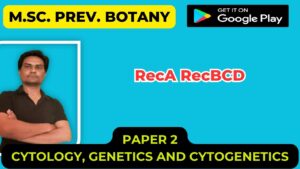Transposable Elements in Eukaryotes:
(a) Transposons in Maize:
- Different types of transposons present in maize are described below:
Ac-Ds system:
- This system of transposable elements in maize was analysed and given by Barbara Mc. Clintock. Here Ac stands for Activator and Ds for Dissociation.
- Barbara found that Ds and Ac genes were sometimes mobile and moved to different chromosomal locations thus resulting in different kernel phenotypes.
- Ds element is activated by Ac and on activation it serves as the site provider for breakage in chromosome.
- Ac can move autonomously while Ds can move only in the presence of Ac (Fig. 6). The transposition involving this Ac-Ds system produces altered kernel phenotypes.
Other transposable elements of maize are:
i. spm (suppressor mutator) system,
ii. dt (dotted) system,
iii. Mu (Mutator) system, etc.

(b) Transposons in Drosophila:
- A number of transposable elements are found in Drosophila which are of different types and account for a quite high fraction of Drosophila genome.
- Some of these transposons are given below:
P-elements:
- These were discovered during the study of ‘hybrid-dysgenesis’ which is a sterility causing condition.
- They are 2.9 kb long and contain 31 bp long inverted terminal repeats High rate of P-element transposition causes hybrid dysgenesis.
- P-elements encode transposase enzyme which helps in their transposition.
- These are also useful as vectors for introducing foreign genes into Drosophila.
Copia-elements:
- Their transposition causes mutations for eye-colour in Drosophila.
- They are of size approximately 5-8 kb with direct terminal repeat (DTR) of about 276 bp at each end.
- Within each of this direct repeats is present short inverted repeat (IR) of about 17 bp length.
- About 10-80 copia- elements are present in cell-genome (Fig. 7).

FB Elements:
- These are the fold back elements present in Drosophila genome.
- These have ability to fold back to form a stem and loop structure due to the presence of long inverted terminal repeats.
- Their transposition results into a changed expression by causing mutation by insertion or by affecting the normal gene expression.
- Other important types of transposable elements found in Drosophila are:
i. I elements,
ii. Mariner elements,
iii. Gypsy elements,
iv. Hobo elements, etc.
(c) Transposons in Humans:
- Transposons in humans are in the form of repetitive DNA which consists of sequences that are interspersed within the entire human genome.
- These sequences are transposable and can move to different locations within the genome.
- These are of following two types:
(1) SINEs (Short Interspersed Elements):
- They are ~ 300 bp long and may be present about 5 lakh times in human genome.
- Alu sequences are the best characterized SINEs in humans.
- These are termed as ‘Alu’ elements because they contain specific nucleotide sequences which are cleaved by the restriction enzyme named Alul.
- Alu elements contain Direct Terminal Repeats (DTR) of 7-20 bp length.
- These DTRs help them in the insertion process during transposition.
(2) LINEs (Long Interspersed Elements):
- They are ~ 6400 bp long and are present about 1 lakh times in the human genome. Most prominent example is LI sequence.
- These transposable elements are some of the most abundant and common families of moderately repeated sequences in human DNA.
Significance of Transposable Elements:
- Transposons may change the structural and functional characteristics of genome by changing their position in the genome.
- Transposable elements cause mutation by insertion, deletion, etc.
- Transposons make positive contribution in evolution as they have tremendous impact on the alteration of genetic organisation of organisms.
- They are useful as cloning vectors also, in gene cloning. For example, P-elements are frequently used as vector for introducing transgenes into Drosophila.
- Transposons may also be used as genetic markers while mapping the genomes.
- Transposon-mediated gene tagging is done for searching and isolation of a particular gene.
Mutation Caused by Transposons:
- Transposons are inserted within genes affecting their function, thus cause disruption of their functions.
- When they are inserted within the regulatory sequence of genes, they cause change in their expression.
- They are most common source of mutation. Transposons may insert stop codons thus producing truncated proteins.
- In drosophilla, majority of spontaneous mutations are caused by transposons jumping into a gene.
- The mutant white-eyed drosphilla is produced by a transposable element inserted into the gene, which normally produces red pigment.
- In human beings, transposons cause many genetic diseases.
- Transposons lead to the development of functional immune system in vertebrates.
- In bacteria, the transposable elements are present on extra chromosomal DNA called plasmid.
- Transposable elements on plasmids carry genes for proteins that nullify the effects of antibacterial drugs and toxins.






